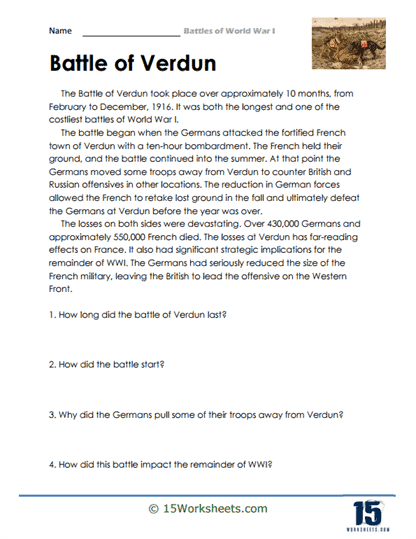Battle of Verdun

Worksheet Description
The worksheet delves into the Battle of Verdun, a momentous conflict during World War I that spanned approximately 10 months, from February to December 1916. Recognized as one of the longest and most devastating battles of the war, it began with a German offensive targeting the fortified French town of Verdun. Despite facing heavy bombardment, the French managed to retain their position through the summer, and as the Germans redirected some of their forces to address other fronts, the French reclaimed the ground in the fall. The clash saw staggering casualties for both sides, with the aftermath underscoring the significant strategic implications for the rest of the war.
To effectively work through this worksheet, students should begin by thoroughly reading the provided text, ensuring they comprehend the chronological sequence, strategies, and the battle’s broader context within World War I. They should note key details like the German offensive, the French resistance, and the subsequent troop movements. After understanding the narrative, students should systematically answer each of the four questions, referencing the text to support their responses. Drawing connections between the events of the Battle of Verdun and their broader implications can provide a comprehensive understanding of its significance.
This worksheet is crafted to provide students with a deep understanding of one of World War I’s defining battles: the Battle of Verdun. It introduces learners to the tactics, strategies, and decisions made by both warring factions during the prolonged engagement. By highlighting the colossal losses and the strategic implications of the battle, students are urged to consider the ripple effects of individual battles on larger wartime narratives. In essence, the worksheet seeks to develop students’ analytical skills, historical comprehension, and their capacity to identify and articulate the wider implications of pivotal military events.
